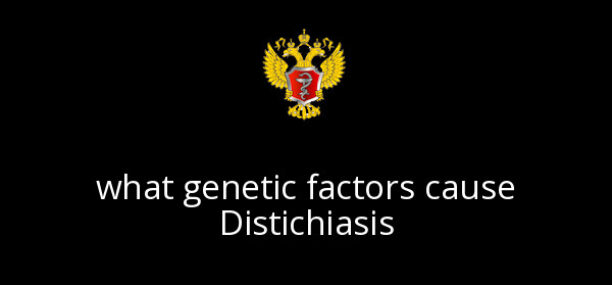Abstract
Distichiasis is believed to have a genetic basis, with mutations in genes such as FOXC2 and SOX18 potentially playing a role in its pathogenesis. The condition can manifest at any age and affects individuals of all genders and ethnic backgrounds. Further research is warranted to elucidate the precise genetic mechanisms underlying distichiasis and its association with demographic factors.
Mutations in the FOXC2 and SOX18 genes can lead to various genetic syndromes involving lymphatic abnormalities, such as lymphedema-distichiasis syndrome and hypotrichosis-lymphedema-telangiectasia syndrome. While these conditions may feature distichiasis as a prominent symptom, they also involve other characteristic clinical manifestations. Additionally, several conditions may mimic distichiasis symptoms, including trichiasis, trichomegaly, madarosis, and eyelash ptosis, each with distinct underlying mechanisms and clinical presentations.
What genetic factors cause Distichiasis?
Distichiasis has been associated with genetic factors, particularly mutations in certain genes that are involved in the development and maintenance of eyelashes and the eyelid margin. While the exact genetic underpinnings of distichiasis are not fully elucidated, studies have implicated several genes in its pathogenesis.
One of the most studied genes in relation to distichiasis is the FOXC2 gene. Mutations in the FOXC2 gene have been associated with a rare condition known as lymphedema-distichiasis syndrome, characterized by distichiasis along with lymphedema (swelling due to lymphatic system dysfunction). The FOXC2 gene plays a crucial role in the development of lymphatic vessels and may also have implications for eyelash development.
Additionally, mutations in genes involved in the regulation of hair follicle development and differentiation, such as the SOX18 gene, have been proposed as potential contributors to distichiasis.
The sequence of events leading to the development of distichiasis likely involves disruptions in the normal embryonic development of the eyelid margin and associated structures. During embryogenesis, aberrant signaling pathways or genetic mutations may lead to the misplacement of eyelashes, resulting in their emergence from the Meibomian gland orifices.
Distichiasis can manifest at any age, but it is often diagnosed during adulthood when individuals begin to experience symptoms such as ocular irritation or tearing. However, some cases may present earlier in childhood, particularly if they are associated with genetic syndromes or congenital abnormalities.
Regarding demographic factors, distichiasis can affect individuals of any gender or ethnic background. It is not restricted to a particular gender or race. However, the prevalence of distichiasis may vary among different populations, and further research is needed to explore potential ethnic or racial differences in susceptibility to the condition.
Mutations or abnormalities in the FOXC2 and SOX18 genes can lead to various medical conditions, including:
1. Lymphedema-Distichiasis Syndrome (LDS):
- This rare genetic disorder is characterized by the combination of lymphedema (swelling due to impaired lymphatic drainage) and distichiasis (abnormal growth of extra eyelashes).
- Lymphedema typically affects the lower limbs and may be present at birth or develop later in life.
- Other features of LDS may include varicose veins, heart defects, and cleft palate.
2. Milroy Disease:
- Milroy disease is a type of primary lymphedema caused by mutations in the FLT4 gene, which encodes a protein involved in lymphatic vessel development.
- Individuals with Milroy disease typically present with congenital lymphedema, often affecting the lower limbs.
- While distichiasis is not a common feature of Milroy disease, some cases may exhibit additional ocular abnormalities.
3. Hypotrichosis-Lymphedema-Telangiectasia Syndrome (HLTS):
- HLTS is a rare genetic disorder characterized by hypotrichosis (sparse hair), lymphedema, and telangiectasia (dilated blood vessels).
- Mutations in the SOX18 gene have been implicated in HLTS, affecting the development of hair follicles, lymphatic vessels, and blood vessels.
- While distichiasis is not a prominent feature of HLTS, the condition may present with other ocular abnormalities.
Conditions that mimic distichiasis symptoms or involve abnormal eyelash growth include:
1. Trichiasis:
- Trichiasis refers to the misdirection of normal eyelashes toward the eye, leading to irritation and potential corneal damage.
- Unlike distichiasis, trichiasis involves the misplacement of normal lashes rather than the growth of extra lashes.
2. Trichomegaly:
- Trichomegaly is characterized by excessive lengthening of eyelashes, which can cause cosmetic concerns or ocular irritation.
- While trichomegaly may resemble distichiasis superficially, it does not involve the abnormal growth of extra lashes from Meibomian gland orifices.
3. Madarosis:
- Madarosis refers to the loss or absence of eyelashes, which can occur due to various causes, including autoimmune diseases, infections, or trauma.
- In some cases, the regrowth of eyelashes following madarosis may result in misdirected lashes or abnormal patterns of growth.
4. Eyelash Ptosis:
- Eyelash ptosis refers to drooping or downward displacement of eyelashes, often resulting from weakness or dysfunction of the muscles or connective tissues supporting the eyelids.
- While eyelash ptosis may cause ocular irritation similar to distichiasis, it involves a different underlying mechanism.
Verified by: Dr.Diab (March 28, 2024)
Citation: Dr.Diab. (March 28, 2024). What genetic factors cause Distichiasis. Medcoi Journal of Medicine, 5(2). urn:medcoi:article32679.













There are no comments yet
Or use one of these social networks